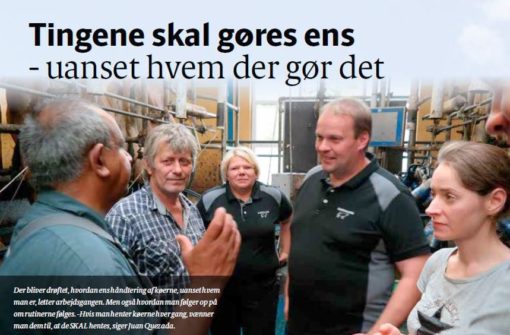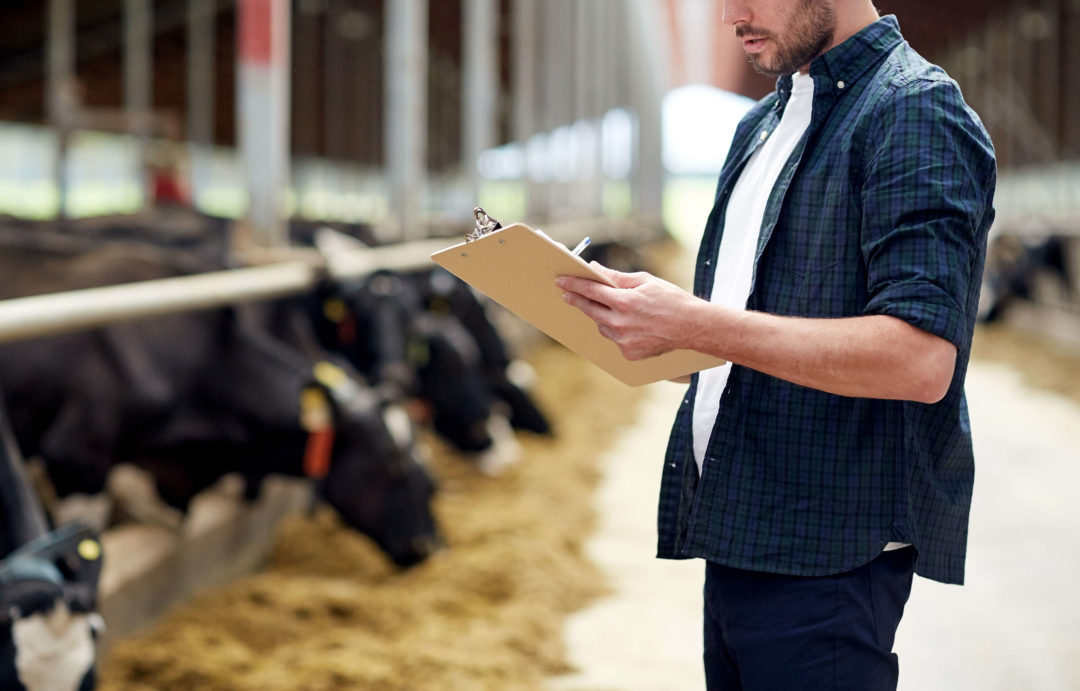This post is also available in:
 Danish
Danish
Cows love regular routines! They relax and can spend time doing what they should do, namely producing milk. If the crew changes frequently and the tasks are done differently, then the tasks will take longer and the animals will have to spend time keeping an eye on whether there is a danger of going or not. A classic example I saw when we did a value stream mapping on a farm. Then the employees discovered that they were driving the cows to the milking parlor on different routes. Therefore, it became clear that animals cannot “help” by walking themselves, because they do not know which way to go today.

Things need to be done the same
Small changes in routines at Kærgård have in six months, meant that one hour of working time is saved daily in the barn and the manager has been given more time in the planning. Read Lone Vestergaard’s article here:Tingene skal gøres ens.
Same procedures are a must
We regularly invite Juan Quezada to Denmark and other European countries. He can train and teach dairy farmers and employees in the barn and in the milking parlor. One of the things that I myself have been completely convinced by working with Juan Quezada is the value of firm procedures.
Juan Quezada is the Director of Training and Development at Milk Source LLC. MilkSource has 34,000 dairy cows (8 farms), 22,000 heifers (1 farm) and 13,000 calves (1 farm) in 4 states of the United States. There are over 660 employees. Their production level is really high and their animals look exceptionally good. These are well-run herds. This can only be done because they run 100% fixed procedures for all tasks. They work to find Best Practice for all tasks and once they have found it it is introduced with written protocols on all farms.
We also have regular protocols in many herds. We call them SOP (Standard Operations Procedures). The text is very short being supplemented with images because images are fast and more secure communication. Not many people have all the procedures outlined, but many have the most essential and expand from there with more and more. It is the experience that the tasks are carried out more similarly, that it is faster and easier to instruct new employees and, thirdly, SOPs help to give a qualified talk among colleagues about the best procedure.
Work plan with standing routines
1. The cows first
When I make a work plan for a cattle farm for example, I start with the needs of the cows. When do they need to be milked, fed, etc. They need tranquility and rhythm so that the tasks are done at the same time every day and in exactly the same way.
2. The competencies next
It is only when all the tasks are set on the day and the week that I begin to put people on. I do not start with names, but with skills. That is, I do not write Per and Poul, but “milker and “operations manager”. It is true that there is replacement among the employees, but it does not mean that the work plan and tasks are moved around every time a new person comes into the team. The tasks must be completely fixed.
When hiring, you need to be sharp about what you are hiring for. You need to know what skills to use. If you do not find 100% the person who can handle all the tasks in the position, then you need to make a performance plan so that he / she is trained in what is missing.
3. People eventually
Only when the work plan is fully established and you know what skills to use in each position can you start to put people on. It is not your current staff that has to decide your work schedule – it must be production, ie the cows. You must meet their needs to get the most and best produced.
You may well now have people who do not want to work Thursday afternoon, for example – or would like to have a little spontaneous leave. You might have made appointments with them about it. You may have to stick with it for a while. But eventually, you need to hire people for the work schedule your production runs best with.

Tranquility and rhythm give work pleasure
I have just helped a customer who has completely changed his work schedule according to the needs of the cows. This meant changing working hours for employees and changing tasks. Therefore, the farmer couple chose to inform the employees one month before the launch and make face-to-face meetings with all of them to ensure that the employees understood the background and were involved in it. As the plan made good sense for production and more calm for the cows, there was good support. In fact, employees got better weekdays and weekends with more rhythm and tranquillity on the tasks as well. The spontaneous planning in the morning was changed to perfectly fixed rhythms.
Some farmers think that employees want variety. But in fact, not many employees will. It gives rise to anxiety and uncertainty when one is often asked to do new things and does not quite know if one is doing well enough. For many people, it is a great pleasure to be allowed to become super-skilled at what you do. And this is best done if it is the same rhythm every day.
.

